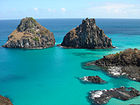- Headlands and bays
-
Headlands and bays are two related features of the coastal environment.
Contents
Geology and geography
Headlands and bays are often found on the same coastline. A bay is surrounded by land on three sides, whereas a headland is surrounded by water on three sides. Headlands are characterized by high, breaking waves, rocky shores, intense erosion, and steep sea cliffs. Bays generally have less wave (and often wind) activity than the water outside the bay, and typically have sandy beaches. Headlands and bays form on discordant coastlines, where bands of rock of alternating resistance run perpendicular to the coast. Bays form where weak (less resistant) rocks (such as sands and clays) are eroded, leaving bands of stronger (more resistant) rocks (such as chalk, limestone, granite) forming a headland, or peninsula. This difference in the rate of erosion is caused by differential erosion. Refraction of waves occurs on headlands concentrating wave energy on them, so many other landforms, such as caves, natural arches and stacks, form on headlands. Wave energy is directed at right angles to the wave crest and lines drawn at right angles to the wave crest (orthogonals) represent the direction of energy expenditure. Orthogonals converge on headlands and diverge in bays which concentrates wave energy on the headlands and dissipating wave energy in the bays.[1] In the formation of sea cliffs, wave erosion undercuts the slopes at the shoreline and they retreat landward. This creases the shear stress in the cliff-forming material and accelerates mass movement.[1] The debris from these landslides collects at the base of the cliff and are also removed by the waves, usually during storms where wave energy is greatest. This debris provides sediment, transported through longshore current for the nearby bay. Joints in the headlands are eroded back to form caves which erode further to form arches. These gaps eventually collapse and leave tall stacks at the ends of the headlands. Eventually these too are eroded by the waves.[2] Wave refraction disperses wave energy through the bay, and along with the sheltering effect of the headlands this protects bays from storms. This effect means that the waves reaching the shore in a bay are weaker than the waves reaching the headland and the bay is thus a safer place for water activities like surfing or swimming. Through the deposition of sediment within the bay and the erosion of the headlands, coastlines eventually straighten out then start the same process all over again
Beach stability
Beaches are dynamic geologic features that can fluctuate between advancement and retreat of sediment. The natural agents of fluctuation include waves, tides, currents, and winds. Man-made elements such as the interruption of sediment supply, such as a dam, and withdrawal of fluid can also affect beach stabilization.[3] A headland bay beach can be classified as being in three different states of sedimentation. Static equilibrium refers to a beach that is stable and does not experience littoral drift or sediment deposition or erosion.[4] Waves generally diffract around the headland(s) and near the beach when the beach is in a state of static equilibrium. Dynamic equilibrium occurs when the beach sediments are deposited and eroded at approximately equal rates.[4] Beaches that have dynamic equilibrium are usually near a river that supplies sediment and would otherwise erode away without the river supply. Unstable beaches are usually off the ocean have little land extending into it.
Notes
- ^ a b Easterbrook, D. (1999). "Surface Processes and Landforms: Second Edition". Prentice Hall].
- ^ Link test.
- ^ Schwartz, M. (2005). "Encyclopedia of Coastal Science" . Springer. ISBN 13 978-1-4020-1903-6 p399
- ^ a b Benedet, L., Klein, A., and Hsu, J. (2004). "Practical Insights and Applications of Empirical Bay Shape Equations". ICCE.
External links
Categories:
Wikimedia Foundation. 2010.


